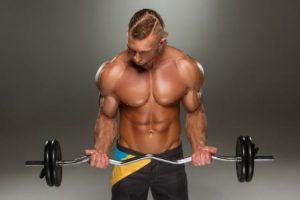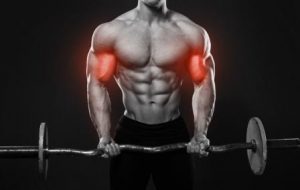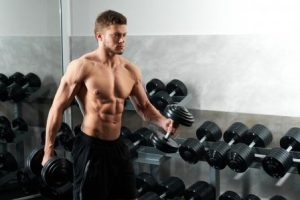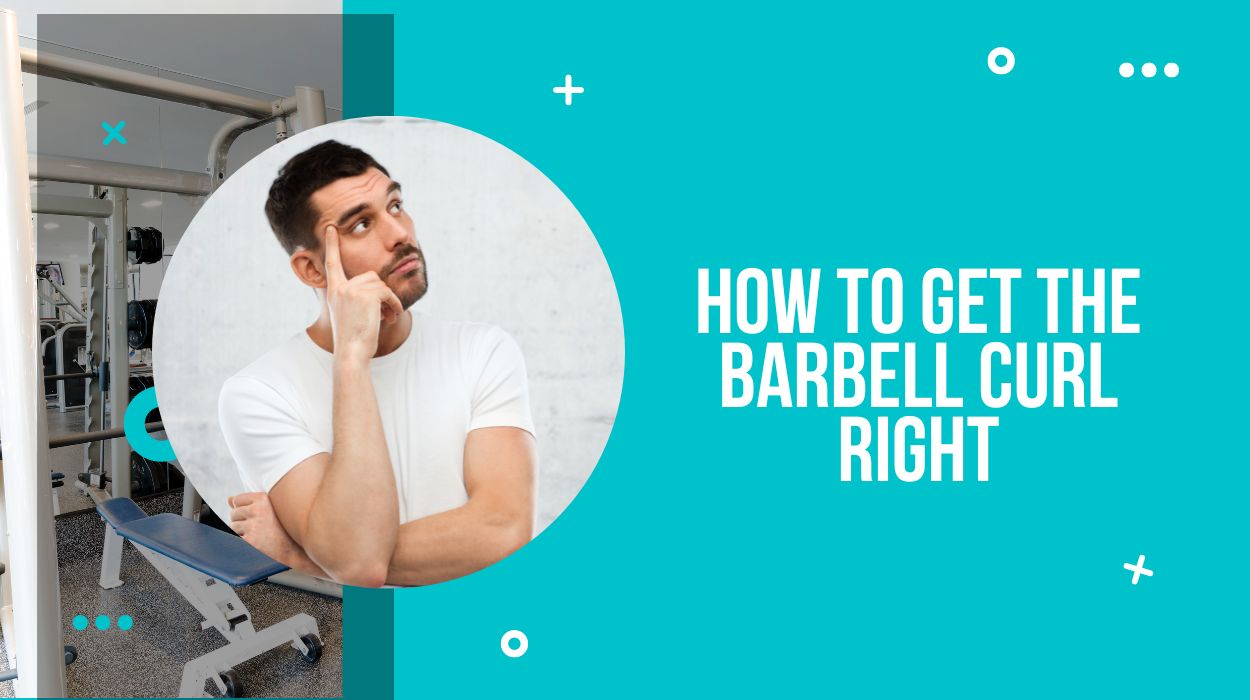Who does not want to build upper body strength? It not only gives you a defined body appearance, but it also helps in enhancing your overall strength. When it comes to upper body strength, you cannot go wrong with the standing barbell curl.
This is an isolated exercise that helps activate your biceps, forearms, etc., along with improving your grip strength. If you delve into the details, standing barbell curl does much more than that. Let us find out its other benefits.
| Utility | Basic |
| Mechanics | Isolated |
| Force | Pull |
Muscles Worked by the Standing Barbell Curl

According to BodyBuilding, the following muscle groups are targeted by the standing barbell curl:
Main Muscle Group:
Biceps branchii
Synergists:
- Brachialis
- Brachioradialis
Dynamic Stabilizers:
- Anterior Deltoid
- Upper and Middle Trapezius
- Wrist Flexors
- Levator Scapulae
We shall learn about them in detail now.
The primary muscle group targeted by the standing barbell curl is the biceps branchii. Overall, it is made up of two heads: long and short.
Collectively, both heads act as one unit while you try to lift or pull something.
When it comes to brachialis, this muscle group is responsible for elbow flexion. Moreover, it generates more than 50% more power than the biceps. It is located beneath the biceps branchii.
Lastly, the Brachioradialis is one of the most prominent and strongest muscles in the forearms. It is responsible for pronation, forearm flexion, and supination.
The dynamic stabilizers like anterior deltoid help in improving your range of motion while the Upper and Middle Trapezius stabilize your shoulders.
Benefits of Standing Barbell Curl

Like we mentioned before, the benefits of standing barbell curl go beyond building your upper body. It helps in the overall improvement. To get a clear idea, the following are some of the benefits you can derive from the standing barbell curl:
Upper Body Mass
It goes without saying that you can bulk up your upper body mass, including your biceps, with the standing barbell curl.
As this exercise helps in stressing the Biceps Branchii muscle group, it gets bigger and stronger.
When you curl, you target the bicep muscles at the front of your upper arm along with the muscles of your lower arm. This helps in building strength as well as the upper body mass.
When you complement this exercise with other exercises targeting your chest and shoulders, you can get your desired body shape. Moreover, a healthy diet will help in fastening the process.
Improved Performance
Once you build your body, you can use your enhanced strength in performing other exercises at the gym. For example, you can do exercises like lat pulldown or barbell row with more ease and diligence with an improved bicep strength.
Pullups will seem more accessible and less painful. With minor soreness to deal with, you can augment your gym experience by inculcating more exercises.
Little to No Injury Risk
As bodybuilders, we understand the drawbacks of certain exercises, especially the toll it takes on your body in the form of injuries.
Weak or underdeveloped biceps are primarily responsible for shoulder pain. It can even lead to grip issues or tearing of the muscles.
To steer clear of such issues, you must include bicep exercises like the standing barbell curl. Since it helps with the development and enhancement of the bicep muscles, you stand a higher chance of coming out of the gym with no injuries or pain.
More Grip Strength
Have you had trouble with pulling exercises? If yes, it could be due to insufficient grip strength. This can be built with the help of the standing barbell curl.
This exercise targets your arm strength as well as the overall grip strength. Furthermore, this leads to more pulling strength. When you pull weights, you get sufficient support from your hands, wrists, and forearms.
Your grip strength will improve with such a combination, giving you a higher chance at correcting your form.
Good for Home Gym
Are you planning on building a home gym without spending a fortune? Well, you can do so as exercises like the standing barbell curl do not require any machines.
You simply need a barbell and some space, and you are good to go! Thus, you can build your biceps even without all the major gym equipment.
How to Perform the Standing Barbell Curl?
Now that we have covered the benefits, it is time to throw some light on the step-by-step instruction. Curling is a simple exercise, but beginners often make mistakes with the form. It leads to no results as well as major injuries.
If you do not want to fall in that criteria, you must perform this exercise in the following manner:
- Choose the bar that you would be comfortable with. For example, you can either use a straight bar or an easy curl bar (zigzag bar). Both of them are equally efficient.
- Stand straight with your knees shoulder-width apart. Keep them lose and not locked up.
- While holding the barbell, keep a soft elbow, and do not lock out your arms.
- Maintain a steady grip on the barbell with your fingers facing up and your thumbs placed on the fingers.
- Breathe out and bring the barbell towards your chin.
- Squeeze your biceps while doing so.
- Hold it for a second.
- Breathe in and return to the starting position.
- Repeat the process.
Common Mistakes to Avoid While Performing Standing Barbell Curl

Even the most advanced lifter or bodybuilder makes mistakes, especially in their initial days. Some mistakes are not that brutal, but others can leave you bruised.
To stay injured, adhere to the following common mistakes that people make during the standing barbell curl.
Body Posture
While performing the standing barbell curls, you need to be aware of your posture during the entire rep.
Firstly, your legs must be shoulder-width apart, and knees must be locked in. Some people tend to keep them straight and stiff. This can lead to injuries.
Speaking of locked in, your elbows must stay in their position too. While curling, you need not move your shoulders. This will transfer the stress from the biceps to your shoulders.
Moreover, your back must not bend while curling. This can also lead to lower back pain.
Not Focusing on Eccentric Overload
While performing the standing barbell curl, you must always stay in form, even while going towards the negatives.
People tend to throw down the weight while returning to their original position. This might lead to wrist and forearm injury.
Going too Fast
If you are in a hurry, it is best to skip this exercise. Simply moving the barbell up and down will not help you build your biceps in a thousand years.
Concentration is a must in this exercise. Slow and controlled motions while curling will lead to stronger and bigger biceps.
Elbow Position
The majority of the lifters end up making a mistake in their elbow positioning. When you curl your biceps, your elbow must remain in its original position. No movement is required in that area.
Once you start moving your elbows away from your torso, you are removing the tension from the biceps. This will not help in achieving your upper body goal. Moreover, it could also lead to injuries.
To fix this, you can reduce the weights that you are lifting.
Swinging the Barbell
While performing this exercise, do not swing the barbell up and down by moving your back.
You must keep an upright spine and tight core while curling. Do not bend your back or move forward.
Sets, Reps, Programming Recommendations for Standing Barbell Curl
You must not do standing barbell curls or any bicep exercise, for that matter, every day. There needs to enough gap for rest.
We recommend doing this exercise four times a week.
You can start with two sets of twelve reps each.
Warming up before the exercise and cooling down after you are finished is a must.
Variations of Standing Barbell Curl

Rather than performing exercise every day, it is advisable to integrate its variations.
The following are some of the most effective variations of the standing barbell curl:
- Dumbbell Bicep Curls
- Reverse Curl
- Hammer Curl
- Zottman Curl
- Preacher Curl
- Kettlebell Curl
- EZ-Bar Curl
- Thick Bar Curl
- Seated Bicep Curl
- Incline Dumbbell Curl
Safety & Precautions for Standing Barbell Curl
To save yourself from returning home from bruises and pain, we recommend you adhere to the following precautionary measures:
- Keep your feet loose and relaxed.
- Your shoulders must be locked in with your elbows touching your torse.
- Work with the weights you are comfortable in.
- Do not bend your back while curling.
- Concentrate on your biceps while curling.
- Focus on slow and controlled motions.
- Keep your body in natural alignment.
- Avoid this exercise if you have a shoulder injury.
Alternatives of Standing Barbell Curl
Do you wish to target your biceps and build upper body strength with other exercises? The following are some of the most fruitful options:
- Chin-up
- Plow pose
- Burpee
- Handstand
- Windmill
- Downward dog
- Bicycle crunches
- Superman exercise
- Sphinx pose
- Chaturanga


